Simin Liu
Neural Spatial-Temporal Tensor Representation for Infrared Small Target Detection
Dec 23, 2024Abstract:Optimization-based approaches dominate infrared small target detection as they leverage infrared imagery's intrinsic low-rankness and sparsity. While effective for single-frame images, they struggle with dynamic changes in multi-frame scenarios as traditional spatial-temporal representations often fail to adapt. To address these challenges, we introduce a Neural-represented Spatial-Temporal Tensor (NeurSTT) model. This framework employs nonlinear networks to enhance spatial-temporal feature correlations in background approximation, thereby supporting target detection in an unsupervised manner. Specifically, we employ neural layers to approximate sequential backgrounds within a low-rank informed deep scheme. A neural three-dimensional total variation is developed to refine background smoothness while reducing static target-like clusters in sequences. Traditional sparsity constraints are incorporated into the loss functions to preserve potential targets. By replacing complex solvers with a deep updating strategy, NeurSTT simplifies the optimization process in a domain-awareness way. Visual and numerical results across various datasets demonstrate that our method outperforms detection challenges. Notably, it has 16.6$\times$ fewer parameters and averaged 19.19\% higher in $IoU$ compared to the suboptimal method on $256 \times 256$ sequences.
Certifying Robustness of Learning-Based Keypoint Detection and Pose Estimation Methods
Jul 31, 2024



Abstract:This work addresses the certification of the local robustness of vision-based two-stage 6D object pose estimation. The two-stage method for object pose estimation achieves superior accuracy by first employing deep neural network-driven keypoint regression and then applying a Perspective-n-Point (PnP) technique. Despite advancements, the certification of these methods' robustness remains scarce. This research aims to fill this gap with a focus on their local robustness on the system level--the capacity to maintain robust estimations amidst semantic input perturbations. The core idea is to transform the certification of local robustness into neural network verification for classification tasks. The challenge is to develop model, input, and output specifications that align with off-the-shelf verification tools. To facilitate verification, we modify the keypoint detection model by substituting nonlinear operations with those more amenable to the verification processes. Instead of injecting random noise into images, as is common, we employ a convex hull representation of images as input specifications to more accurately depict semantic perturbations. Furthermore, by conducting a sensitivity analysis, we propagate the robustness criteria from pose to keypoint accuracy, and then formulating an optimal error threshold allocation problem that allows for the setting of a maximally permissible keypoint deviation thresholds. Viewing each pixel as an individual class, these thresholds result in linear, classification-akin output specifications. Under certain conditions, we demonstrate that the main components of our certification framework are both sound and complete, and validate its effects through extensive evaluations on realistic perturbations. To our knowledge, this is the first study to certify the robustness of large-scale, keypoint-based pose estimation given images in real-world scenarios.
Research on Information Extraction of LCSTS Dataset Based on an Improved BERTSum-LSTM Model
Jun 26, 2024



Abstract:With the continuous advancement of artificial intelligence, natural language processing technology has become widely utilized in various fields. At the same time, there are many challenges in creating Chinese news summaries. First of all, the semantics of Chinese news is complex, and the amount of information is enormous. Extracting critical information from Chinese news presents a significant challenge. Second, the news summary should be concise and clear, focusing on the main content and avoiding redundancy. In addition, the particularity of the Chinese language, such as polysemy, word segmentation, etc., makes it challenging to generate Chinese news summaries. Based on the above, this paper studies the information extraction method of the LCSTS dataset based on an improved BERTSum-LSTM model. We improve the BERTSum-LSTM model to make it perform better in generating Chinese news summaries. The experimental results show that the proposed method has a good effect on creating news summaries, which is of great importance to the construction of news summaries.
Synthesis and verification of robust-adaptive safe controllers
Nov 01, 2023



Abstract:Safe control with guarantees generally requires the system model to be known. It is far more challenging to handle systems with uncertain parameters. In this paper, we propose a generic algorithm that can synthesize and verify safe controllers for systems with constant, unknown parameters. In particular, we use robust-adaptive control barrier functions (raCBFs) to achieve safety. We develop new theories and techniques using sum-of-squares that enable us to pose synthesis and verification as a series of convex optimization problems. In our experiments, we show that our algorithms are general and scalable, applying them to three different polynomial systems of up to moderate size (7D). Our raCBFs are currently the most effective way to guarantee safety for uncertain systems, achieving 100% safety and up to 55% performance improvement over a robust baseline.
Learning the Positions in CountSketch
Jun 11, 2023Abstract:We consider sketching algorithms which first compress data by multiplication with a random sketch matrix, and then apply the sketch to quickly solve an optimization problem, e.g., low-rank approximation and regression. In the learning-based sketching paradigm proposed by~\cite{indyk2019learning}, the sketch matrix is found by choosing a random sparse matrix, e.g., CountSketch, and then the values of its non-zero entries are updated by running gradient descent on a training data set. Despite the growing body of work on this paradigm, a noticeable omission is that the locations of the non-zero entries of previous algorithms were fixed, and only their values were learned. In this work, we propose the first learning-based algorithms that also optimize the locations of the non-zero entries. Our first proposed algorithm is based on a greedy algorithm. However, one drawback of the greedy algorithm is its slower training time. We fix this issue and propose approaches for learning a sketching matrix for both low-rank approximation and Hessian approximation for second order optimization. The latter is helpful for a range of constrained optimization problems, such as LASSO and matrix estimation with a nuclear norm constraint. Both approaches achieve good accuracy with a fast running time. Moreover, our experiments suggest that our algorithm can still reduce the error significantly even if we only have a very limited number of training matrices.
Safe Control Under Input Limits with Neural Control Barrier Functions
Nov 20, 2022Abstract:We propose new methods to synthesize control barrier function (CBF)-based safe controllers that avoid input saturation, which can cause safety violations. In particular, our method is created for high-dimensional, general nonlinear systems, for which such tools are scarce. We leverage techniques from machine learning, like neural networks and deep learning, to simplify this challenging problem in nonlinear control design. The method consists of a learner-critic architecture, in which the critic gives counterexamples of input saturation and the learner optimizes a neural CBF to eliminate those counterexamples. We provide empirical results on a 10D state, 4D input quadcopter-pendulum system. Our learned CBF avoids input saturation and maintains safety over nearly 100% of trials.
Safety Index Synthesis via Sum-of-Squares Programming
Sep 19, 2022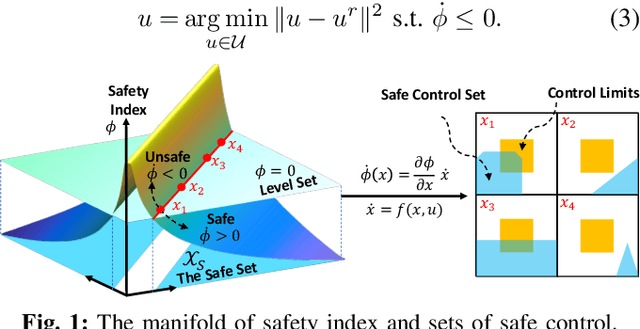
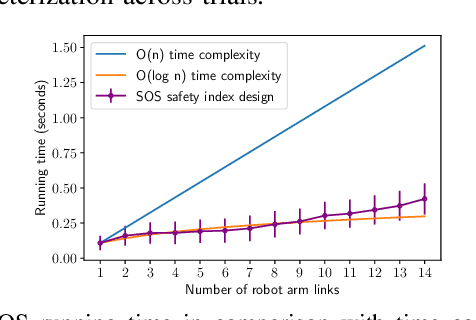
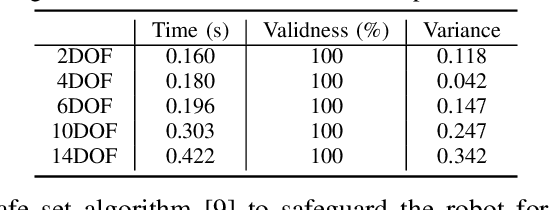

Abstract:Control systems often need to satisfy strict safety requirements. Safety index provides a handy way to evaluate the safety level of the system and derive the resulting safe control policies. However, designing safety index functions under control limits is difficult and requires a great amount of expert knowledge. This paper proposes a framework for synthesizing the safety index for general control systems using sum-of-squares programming. Our approach is to show that ensuring the non-emptiness of safe control on the safe set boundary is equivalent to a local manifold positiveness problem. We then prove that this problem is equivalent to sum-of-squares programming via the Positivstellensatz of algebraic geometry. We validate the proposed method on robot arms with different degrees of freedom and ground vehicles. The results show that the synthesized safety index guarantees safety and our method is effective even in high-dimensional robot systems.
Overview of FPGA deep learning acceleration based on convolutional neural network
Dec 23, 2020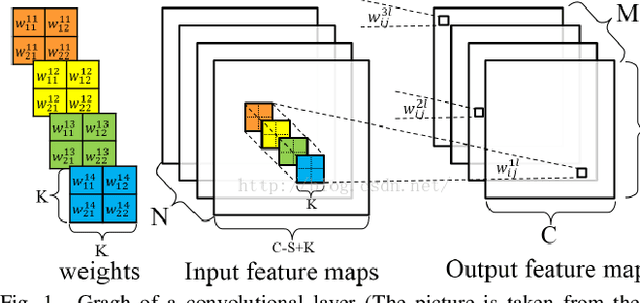
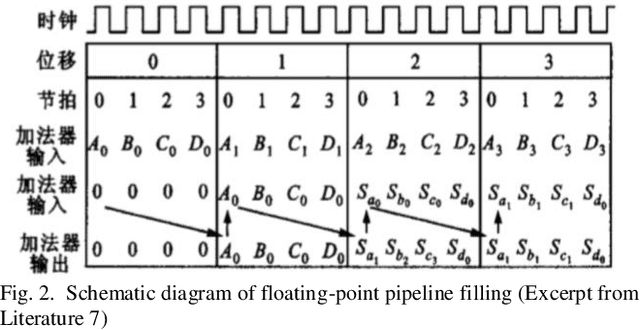
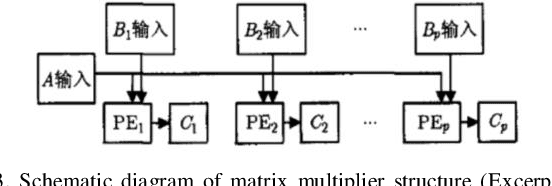
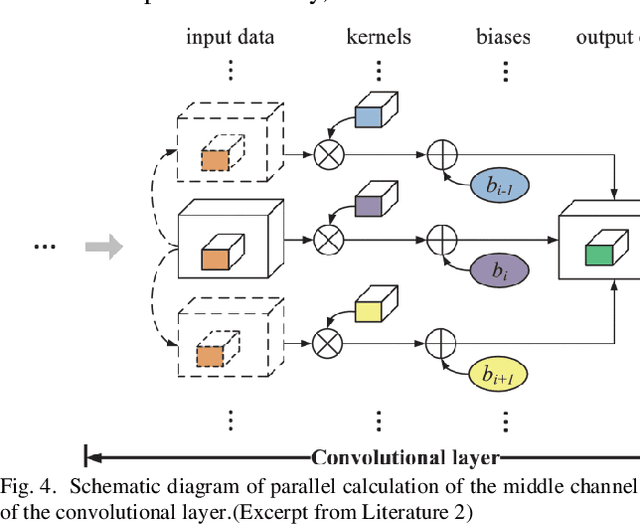
Abstract:In recent years, deep learning has become more and more mature, and as a commonly used algorithm in deep learning, convolutional neural networks have been widely used in various visual tasks. In the past, research based on deep learning algorithms mainly relied on hardware such as GPUs and CPUs. However, with the increasing development of FPGAs, both field programmable logic gate arrays, it has become the main implementation hardware platform that combines various neural network deep learning algorithms This article is a review article, which mainly introduces the related theories and algorithms of convolution. It summarizes the application scenarios of several existing FPGA technologies based on convolutional neural networks, and mainly introduces the application of accelerators. At the same time, it summarizes some accelerators' under-utilization of logic resources or under-utilization of memory bandwidth, so that they can't get the best performance.
On Learned Sketches for Randomized Numerical Linear Algebra
Jul 20, 2020



Abstract:We study "learning-based" sketching approaches for diverse tasks in numerical linear algebra: least-squares regression, $\ell_p$ regression, Huber regression, low-rank approximation (LRA), and $k$-means clustering. Sketching methods are used to quickly and approximately compute properties of large matrices. Linear maps called "sketches" are applied to compress data, and these concise representations are used to compute the desired properties. Specifically, we consider sparse sketches (such as CountSketch). Recent works have dealt with optimizing sketches for data distributions to perform better than their random counterparts. We extend this theme to several important and ubiquitous tasks, each of which requires a new analysis and novel practical methods. Specifically, our contributions are: 1) For all tasks, we introduce fast algorithms using learned sketches with worst-case guarantees. We give a simple task-agnostic method for retaining the worst-case guarantees of randomized sketching, which yields time-optimal algorithms for LRA and least-squares regression. Also, for $k$-means clustering, we give a faster alternative for retaining worst-case guarantees. 2) We show empirically that learned sketches are reliable in improving approximation accuracy, with comparison against "non-learned" sketching baselines. 3) We introduce a greedy algorithm for optimizing the location of the nonzero entries of a sparse sketch and prove guarantees for certain distributions on the LRA task. Previous work only looked at optimizing the values rather than the locations. Also, we show empirically that it further improves learned sketch performance.
Learning to Adapt in Dynamic, Real-World Environments Through Meta-Reinforcement Learning
Feb 27, 2019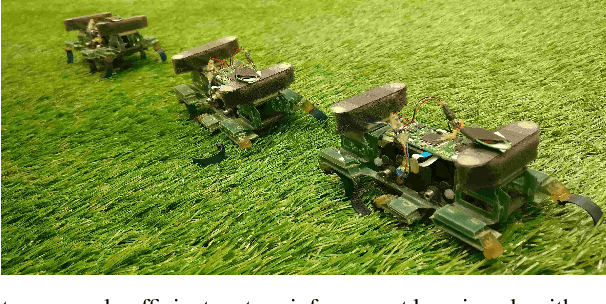
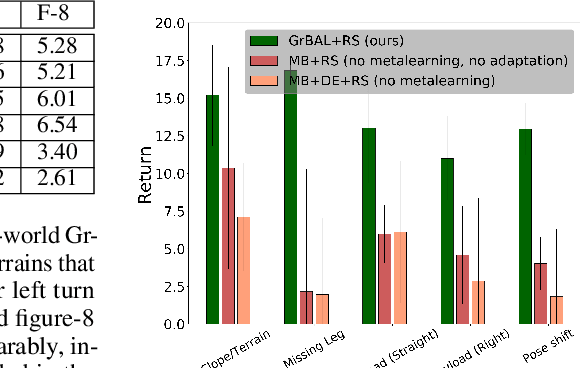
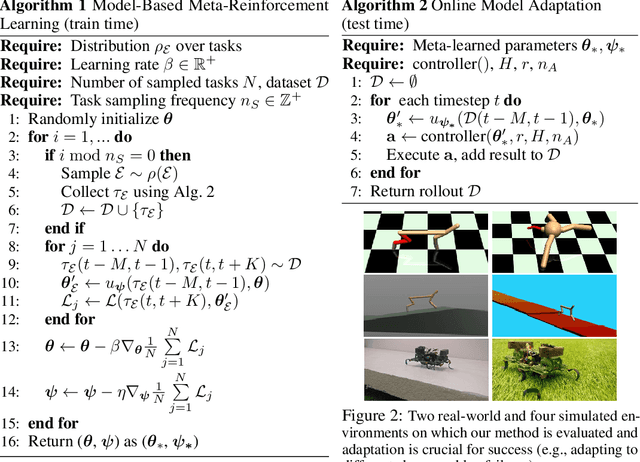
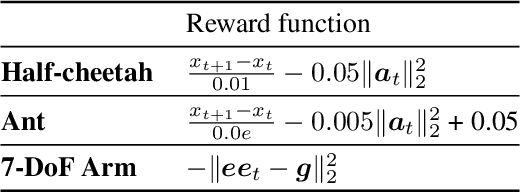
Abstract:Although reinforcement learning methods can achieve impressive results in simulation, the real world presents two major challenges: generating samples is exceedingly expensive, and unexpected perturbations or unseen situations cause proficient but specialized policies to fail at test time. Given that it is impractical to train separate policies to accommodate all situations the agent may see in the real world, this work proposes to learn how to quickly and effectively adapt online to new tasks. To enable sample-efficient learning, we consider learning online adaptation in the context of model-based reinforcement learning. Our approach uses meta-learning to train a dynamics model prior such that, when combined with recent data, this prior can be rapidly adapted to the local context. Our experiments demonstrate online adaptation for continuous control tasks on both simulated and real-world agents. We first show simulated agents adapting their behavior online to novel terrains, crippled body parts, and highly-dynamic environments. We also illustrate the importance of incorporating online adaptation into autonomous agents that operate in the real world by applying our method to a real dynamic legged millirobot. We demonstrate the agent's learned ability to quickly adapt online to a missing leg, adjust to novel terrains and slopes, account for miscalibration or errors in pose estimation, and compensate for pulling payloads.
 Add to Chrome
Add to Chrome Add to Firefox
Add to Firefox Add to Edge
Add to Edge